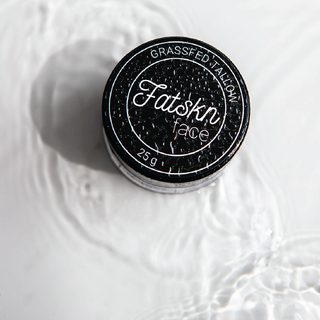Tallow is beef fat.
There. I said it.
Stay with me....
OK so it's beef fat that is "purified" aka rendered which is the process of heating the fat at a low temperature for a long time. Similar to cold pressing, by treating the fat at a low temperature without boiling it, the beneficial properties of the fat remain intact.
As the tallow is rendered, it melts into a beautiful golden liquid that is solid, stable and creamy white at room temperature.
Tallow vs. lard vs. suet?
Tallow is the rendered fat of ruminant animals (cows, sheep, goats, etc.)
Lard is the rendered fat of pigs. We often save (high quality) bacon grease to cook potatoes and onions in. It gives everything a wonderful flavour and, like tallow, has a high smoke point.
Suet is specifically the fat around the organs. It is a harder fat, with a higher ration of saturated fat as opposed to the "killing" fats, which is softer and has a higher ratio of PUFAs (polyunsaturated fatty acids) throughout the rest of the animal. We use the harder suet tallow for all of our products as we believe they are more nutrient dense and have a better fatty acid profile. We also prefer working with fats with a harder consistency at room temperature.
Does the animal's food affect the quality of the tallow?
There are three different types of cattle (with regards to diet):
- Grainfed and grainfinished
- Grassfed and grainfinished
- Grassfed and grassfinished
1. Grainfed and grainfinished: The most common type of commercially-raised cattle as it is the cheapest and requires the least amount of land to raise the cattle. The animals are fed a variety of things, often byproducts of large industries, including corn, distillers (brewers) grains, sorghum, barley, and by-products of numerous grain and fiber milling processes. Steers fed higher grain diets grow faster, finish sooner, and produce heavier and fatter carcasses.
Here's a quote from the Canadian Beef Cattle Research Council about optimizing feedlot efficiency:
"Ionophores are antimicrobials (which are categorized as ‘Low Importance’ in human medicine and are not used to treat bacterial infections in humans) delivered through cattle feed that improve nutrient availability to the animal. They can improve feed efficiency and weight gain, reduce methane production, reduce the incidence of bloat and acidosis, and prevent diseases like coccidiosis."
Personally, if I'm eating food that is giving me bloating, gas and increasing my chances of diseases, my first act would be to identify and cut out the offending foods. Needing to add ionophores to feedlot food signifies to me that the animal is not eating the diet it is meant to eat. If I don't nourish myself this way then why would I want to consume something that was raised like this? I believe feedlot meat to be the least desirable meat on the planet. That said, the nutritional value and digestibility of sub-par meat is still far superior than vegan "egg" or "meat".
2. Grassfed and grainfinished: This represents roughly 80% of beef available to consumers. These cows spend their lives grazing in open grasslands and are fed hay (cut and dried grasses) in the winter. They are finished with grain and grain by-products (the same feedlot food as listed above) to fatten them up - as quickly as possible - and basically butcher them just before their organs fail and they die from overfeeding.
3. Grassfed and grassfinished: I believe this is the best type of cattle. They live their whole lives eating what they would eat if we didn't exist. Because they are never fed grain by-products etc., they are typically leaner than the other two options. They are chock full of saturated fatty acids and vitamins thanks to their grazing diets and spend their lives outside, in the glorious sun, like cows should. Grassfed cattle is also the most sustainable method for raising beef based on the theory of regenerative agriculture (or holistic management). The manure returns the nutrients to the soil, which helps deep-rooted grasses grow and prevent erosion.
What kind of tallow does FATSKN use?
FATSKN suet tallow that is 100% grassfed and grassfinished, which is by far the best type of tallow. Here are some reasons it's so good for our skin:
- All those extra vitamins (A, D, E, K) are fat-soluble vitamins (only found in animal products) which means they're readily absorbed and used by our skin, which encourages and promotes skin cell regeneration.
- It is primarily a saturated fat, which means it won't oxidize when exposed to heat or light. It is incredibly stable at room temperature (and you can throw it in the fridge to extend its life by many years) which eliminates the need to add any nasty, unusable preservatives.
- It's non-greasy and "bio-identical" to human skin which essentially means that it's 100% usable by our body and easy to absorb.
- It is safe and natural skincare. Safe for babies and pregnant women - which is the whole reason I created this product in the first place.
- It is truly food for your skin.
- It helps prevent stretchmarks and reduce inflammation (I didn't get any stretchmarks on my first or second pregnancy - I gained 40 pounds both times. I have stretchmarks on my thighs, bum and boobs from puberty, so I am not genetically immune from them). * I also attribute this to my diet - rich in animal proteins and fats (glycine, collagen, gelatin). Sufficient calories from nutrient-dense, real whole food.
Hopefully this gives you a good introduction to the benefits of tallow. If you have any more questions that I haven't answered here or in another blog post, please reach out to me: caitlin@fatskn.com or send us a message on Facebook (@fatskn.care) or Instagram (@fatskn).

